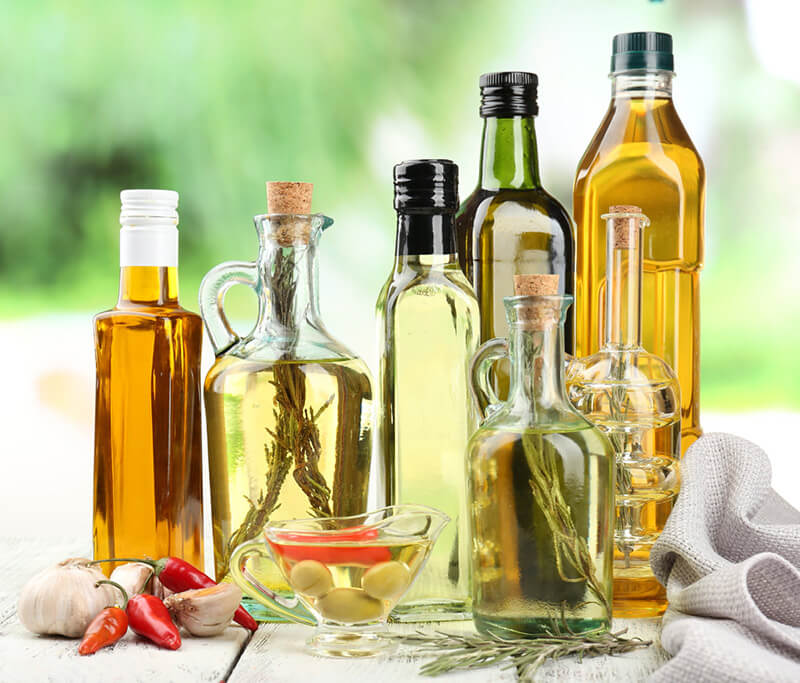
Edible oils not only have a big contribution in our diet as cooking oil, salad oil, and for food product formulation, but also are widely used in the manufacturing of cosmetic products and biodiesel fuel feedstock. Thus, edible oils have very high nutritional and economic values. However, adulteration of edible oil has emerged as a major issue worldwide due to their increasing market demand and the potential profit. It has, therefore, become essential to monitor the purity and quality of edible oils to reduce various risks.
Lifeasible has many years of experience in food testing. We provide a variety of testing methods for different types of edible oil adulterations, which include, but not limited to:
Cold press oil is more expensive than refined oil because the refining processes generally produce trans fatty acids and steradienes, which can increase the risk of coronary heart disease. Therefore, some manufacturers tempt to admix cold press oil by refined oil; and trans fatty acids and/or steradienes can be used as markers to discriminate this type of oil adulterations.
The substitution of more expensive oil by cheaper oil is obviously profitable for producers, and is, therefore, a common type of oil adulteration. For instance, olive oil has low content of saturated fatty acid and polyunsaturated fats, and high content of the healthier monounsaturated fats, and is therefore widely accepted as healthy edible oil, which has been proved to lower the risk of heart diseases. Therefore, olive oil is frequently adulterated with other types of cheaper oils to increase profit.
Major components in edible oils and fats are triacylglycerols (TAG) composed of fatty acids and minor components are sterols, carotenoids, tocophe rols, chlorophylls, and other minor compounds. Some oils have particular components which are absent in other ones. Therefore, variations in fat compositions can be a detectable feature for oil adulterations. For example, ΔECN42 (indicates the difference between the theoretical and experimental equivalent carbon number 42 in TAG) can be used to detect olive oil adulterations by sunflower, soybean, cotton, corn, safflower, canola, and rapeseed oils. (E)-5-methylhept-2-en-4-one (filbertone) has been identified as the flavoring component of hazelnuts which is present in some level in hazelnut oil. Brassicasterol is a sterol which is almost exclusively present in canola oil. Sesamin or sesamolin are present exclusively in sesame oil. Δ7-stigmasterol and campesterol have been used to detect olive oil adulteration with sunflower and soybean oil. 4,4´-dimethyl-sterols could be used as markers to detect virgin olive oil adulteration with hazelnut oil.
Peroxide value, acid value, saponification value, and iodine value are often used to determine the quality of edible oils and to ensure they are of correct grades. A high peroxide value indicates poor quality. The acid value reflects the amount of free fatty acids, and is used for detection of hydrolytic rancidity. Edible oils containing short-chain acids will have more carboxyl groups than long chain fatty acids per gram and will have higher saponification numbers. Iodine value reflects the degree of unsaturation of the edible oil tested. The iodine value increases as the degree of unsaturation increases.
Inedible used oils refer to swill oils collected from kitchen wastes, waste cooking oils recycled from gutters, residual oils stewed from animal fats, deep-frying oils, and other inedible oils. They are always polluted by patterns of chemical toxins and potential carcinogens, including heavy metal ions, peroxides, trans fatty acids, aflatoxin B1, and polycyclic aromatic hydrocarbons (PAHs), depending on their sources or origins. The pollutants can be used as markers to discriminate inedible used oils.
In a number of cases, adulteration of Argemone mexicana seed oil in edible oils has been reported to lead to epidemic dropsy, glaucoma, and loss of eyesight. Therefore, there is an urgent need for prevention of argemone oil adulteration for the health and safety of consumers. Two of the major toxic ingredients present in Argemone are sanguinarine and dihydrosanguinarine (alkaloids).
At Lifeasible, a full array of analytical methods are adopted to detect adulteration of edible oils including chromatography techniques (e.g., gas chromatography (GC), high-performance liquid chromatography (HPLC), supercritical fluid chromatography (SFC) in combination with evaporative light scattering detection (ELSD), thin layer chromatography (TLC), etc.), spectroscopy techniques (e.g., near infrared (NIR) spectroscopy, attenuated total reflectance (ATR)-Fourier transform infrared (FTIR) spectroscopy, Raman spectroscopy, inductively coupled plasma-optical emission spectroscopy (ICP-OES), and nuclear magnetic resonance (NMR) spectroscopy), mass spectrometry methods (e.g., electrospray ionization mass spectrometry (ESI-MS)), and so on. We can help you find the most tailored solutions for the detection of adulterations in edible oils. Our edible oil adulteration testing services are featured with high sensitivity and short turnaround times. Please feel free to contact us if you need any further information.
Lifeasible has established a one-stop service platform for plants. In addition to obtaining customized solutions for plant genetic engineering, customers can also conduct follow-up analysis and research on plants through our analysis platform. The analytical services we provide include but are not limited to the following:
Get Latest Lifeasible News and Updates Directly to Your Inbox
Adaptive Evolutionary Mechanism of Plants
February 28, 2025
Unraveling Cotton Development: Insights from Multi-Omics Studies
February 27, 2025